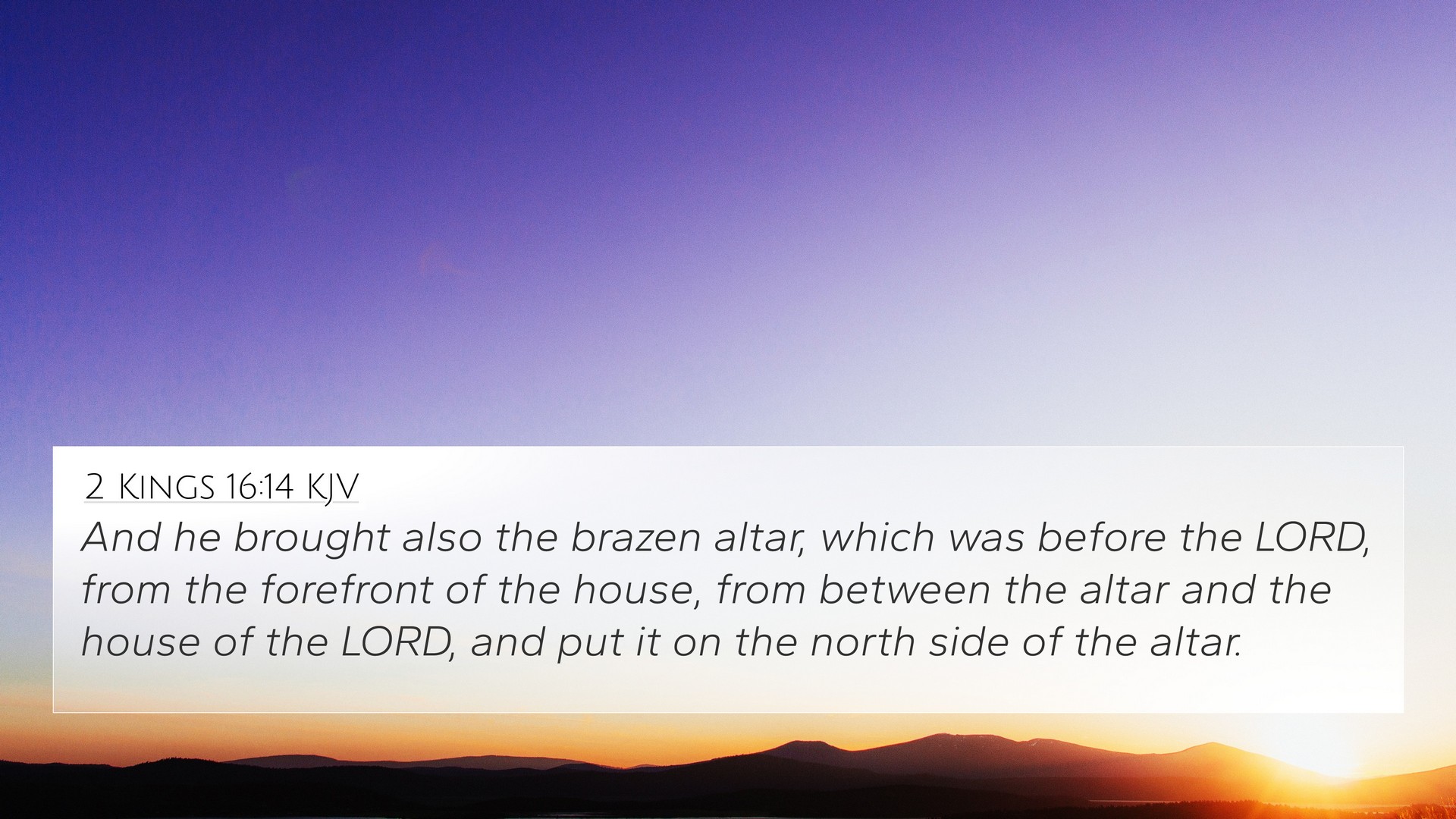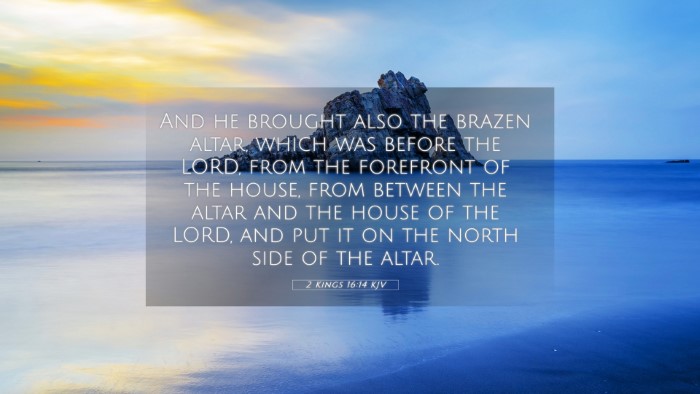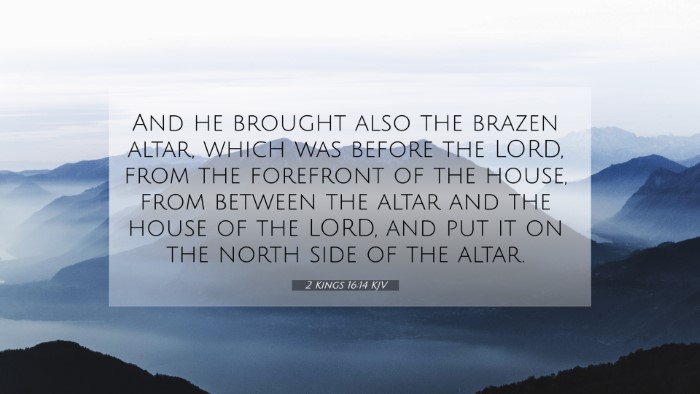Old Testament
Genesis Exodus Leviticus Numbers Deuteronomy Joshua Judges Ruth 1 Samuel 2 Samuel 1 Kings 2 Kings 1 Chronicles 2 Chronicles Ezra Nehemiah Esther Job Psalms Proverbs Ecclesiastes Song of Solomon Isaiah Jeremiah Lamentations Ezekiel Daniel Hosea Joel Amos Obadiah Jonah Micah Nahum Habakkuk Zephaniah Haggai Zechariah Malachi2 Kings 16:14 Similar Verses
2 Kings 16:14 Cross References
And he brought also the brazen altar, which was before the LORD, from the forefront of the house, from between the altar and the house of the LORD, and put it on the north side of the altar.
Uncover the Rich Themes and Topics of This Bible Verse
Listed below are the Bible themes associated with 2 Kings 16:14. We invite you to explore each theme to gain deeper insights into the Scriptures.
2 Kings 16:14 Cross Reference Verses
This section features a detailed cross-reference designed to enrich your understanding of the Scriptures. Below, you will find carefully selected verses that echo the themes and teachings related to 2 Kings 16:14 KJV. Click on any image to explore detailed analyses of related Bible verses and uncover deeper theological insights.
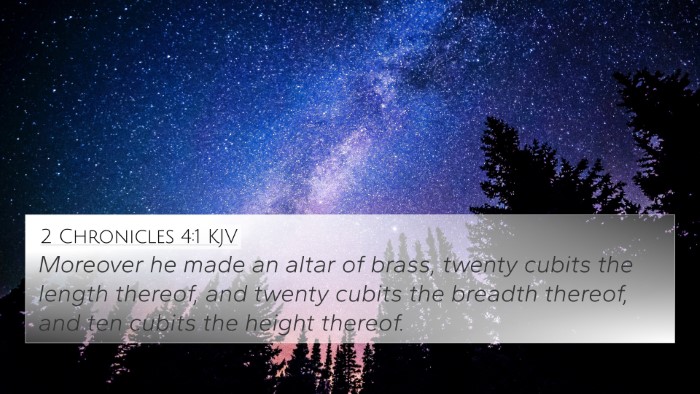
2 Chronicles 4:1 (KJV) »
Moreover he made an altar of brass, twenty cubits the length thereof, and twenty cubits the breadth thereof, and ten cubits the height thereof.
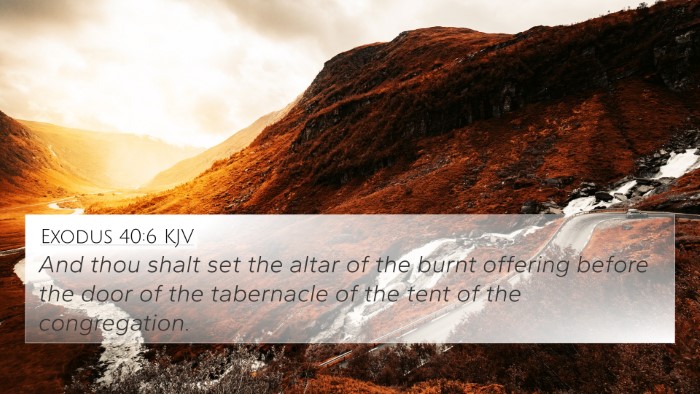
Exodus 40:6 (KJV) »
And thou shalt set the altar of the burnt offering before the door of the tabernacle of the tent of the congregation.
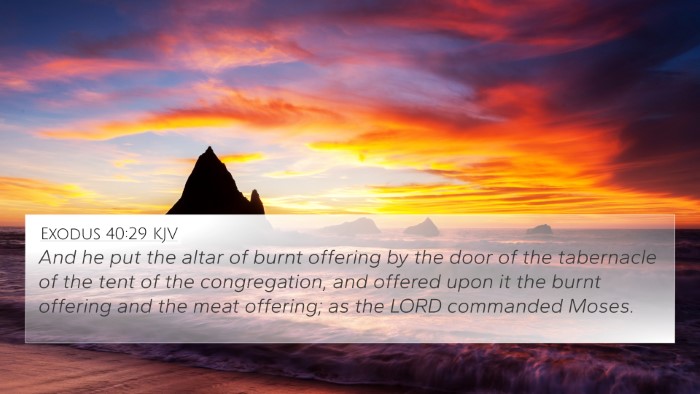
Exodus 40:29 (KJV) »
And he put the altar of burnt offering by the door of the tabernacle of the tent of the congregation, and offered upon it the burnt offering and the meat offering; as the LORD commanded Moses.
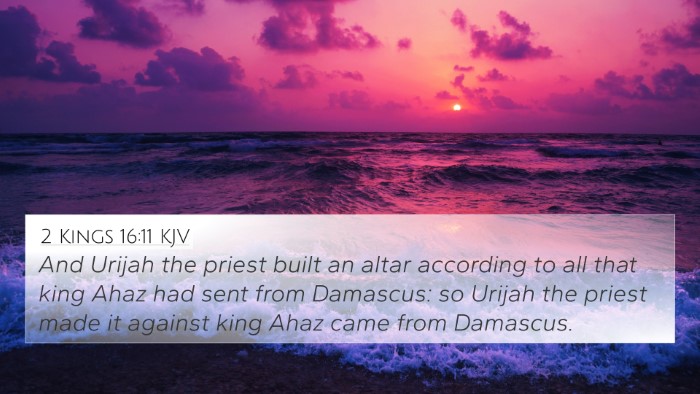
2 Kings 16:11 (KJV) »
And Urijah the priest built an altar according to all that king Ahaz had sent from Damascus: so Urijah the priest made it against king Ahaz came from Damascus.

2 Chronicles 1:5 (KJV) »
Moreover the brazen altar, that Bezaleel the son of Uri, the son of Hur, had made, he put before the tabernacle of the LORD: and Solomon and the congregation sought unto it.
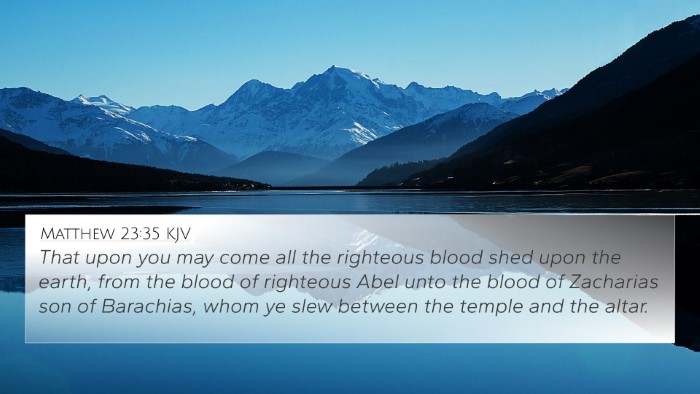
Matthew 23:35 (KJV) »
That upon you may come all the righteous blood shed upon the earth, from the blood of righteous Abel unto the blood of Zacharias son of Barachias, whom ye slew between the temple and the altar.
2 Kings 16:14 Verse Analysis and Similar Verses
Understanding 2 Kings 16:14
2 Kings 16:14 reads:
“And he brought also the brasen altar, which was before the Lord, from the temple, from between the altar and the house of the Lord, and put it on the north side of the altar.”
Context and Overview
The passage occurs during the reign of King Ahaz of Judah, a time characterized by spiritual decline and idolatry. This verse is significant in illustrating the actions taken by Ahaz as he adapted the worship practices of Israel and sought favor with foreign powers, particularly in light of the threats he faced from Syria and Israel.
Commentary Insights
Matthew Henry's Perspective
Matthew Henry emphasizes the implications of Ahaz’s actions regarding the brazen altar. He notes that removing the brazen altar from its sacred position reveals a profound disrespect for God's ordained worship. Henry suggests that this act not only signifies a shift away from traditional worship but also highlights Ahaz’s failure to consult God in times of crisis, favoring instead the customs of the surrounding nations.
Albert Barnes' Explanation
Albert Barnes focuses on the practical aspects of Ahaz's reconfiguration of the temple. He explains that the brazen altar, meant for proper sacrifices, was being placed in a position that could lead to syncretism—the blending of worship of Yahweh with practices from surrounding pagan cultures. Barnes advocates that such actions represent a pivotal moment of apostasy in Israel's history, marking a departure from authentic worship.
Adam Clarke's Analysis
Adam Clarke provides a detailed interpretation of the geographic implications of Ahaz's altar placement. He suggests that placing the altar on the northern side indicates a compromise where the king seeks to satisfy both his religious obligations and political motives. Clarke warns that this alteration symbolizes a deeper corruption and a misinterpretation of divine guidance and worship.
Key Themes
- Apostasy: The verse reflects a critical moment of turning away from God's commandments.
- Idolatry: Ahaz's actions are illustrative of adopting foreign practices at the expense of sacred traditions.
- Political Motivations: The blend of politics and religion during this time highlights the complexity of Ahaz's rule.
- Worship Shift: A crucial alteration in how God intended worship to be conducted among His people.
Bible Cross-References
This verse connects to several other biblical texts, illustrating a broader narrative about worship practices, the nature of idolatry, and leadership in Israel:
- 2 Kings 12:13-14: Discusses the proper use of sacred items in worship.
- 2 Chronicles 28:24: Ahaz’s further actions of desecration within the temple.
- Isaiah 7:1-2: Situates Ahaz within the context of conflict with surrounding nations.
- Exodus 20:4-5: God’s commands on idolatry and false worship.
- 1 Kings 12:26-30: The establishment of alternative worship sites in Israel which leads to idolatry.
- Jeremiah 7:30-31: References the evil of idol worship and the desecration of God’s house.
- Ezekiel 8:5-12: A vision of idol worship within the temple, echoing Ahaz’s misdeeds.
Thematic Connections
This passage serves as a valuable example of the connections between Bible verses and the linking of Bible scriptures. Understanding 2 Kings 16:14 through the lens of other scriptures enhances the overall comprehension of the themes of worship and fidelity to God's law. The thematic Bible verse connections remind us how corruption in worship can lead to broader societal declines.
Tools for Cross-Referencing
Engaging in cross-referencing Bible study promotes a deeper understanding of biblical interpretations. Tools such as Bible concordances and cross-reference Bible study guides are essential for identifying and analyzing the intricate relationships between these texts. For example:
- Bible cross-reference system: A structured approach for understanding scripture parallels.
- Cross-referencing Bible study methods: Techniques to dive into themes for deeper insight.
Conclusion
The actions of Ahaz in 2 Kings 16:14 encapsulate a significant turning point in Israel's history, leading to critical reflections on worship, idolatry, and the need for steadfastness in faith. As we explore the Bible verses that relate to each other and engage in comparative Bible verse analysis, we can glean lessons relevant to contemporary discussions of faith and practice.
Through an understanding of Bible verse parallels, we recognize that the struggles of the past offer timeless lessons applicable to our lives today.
